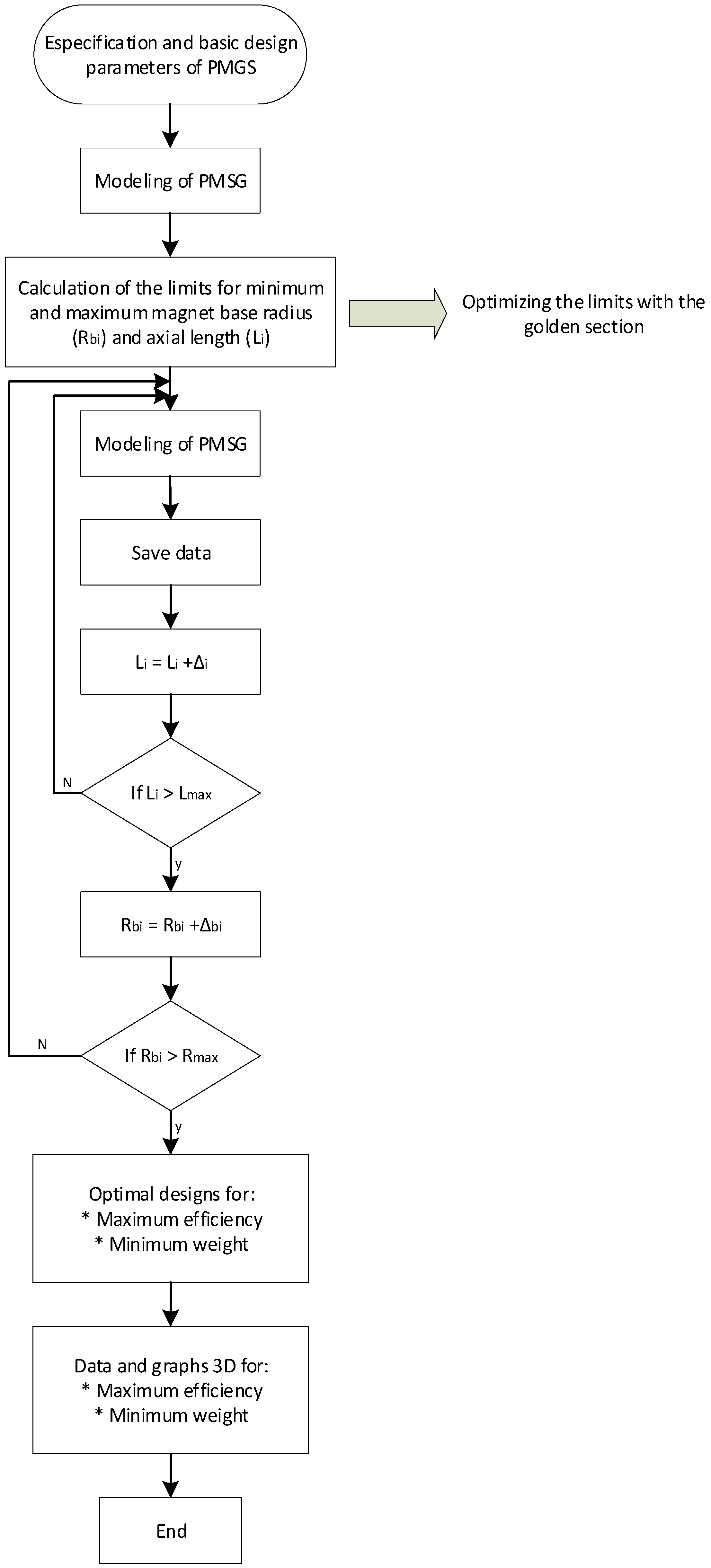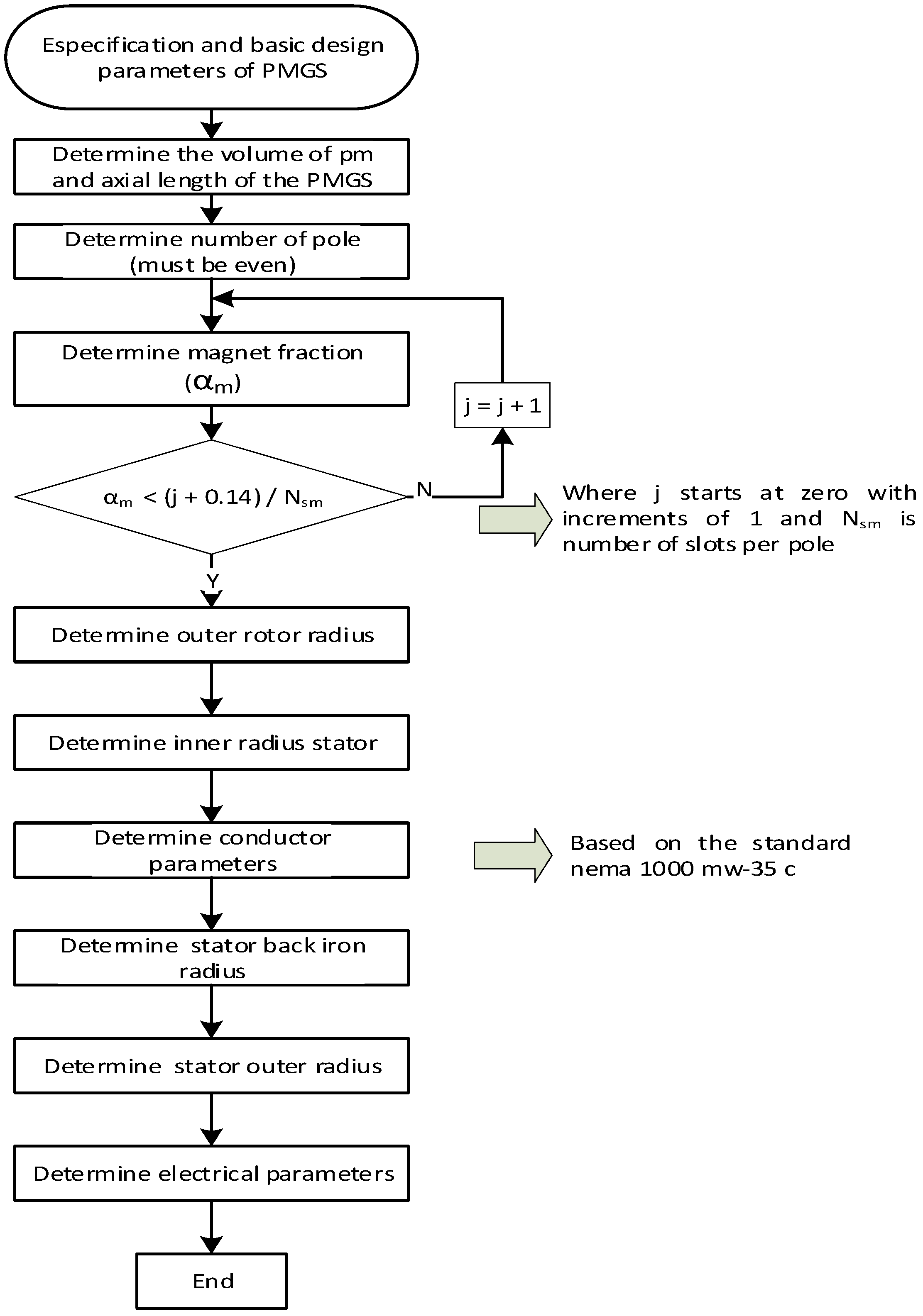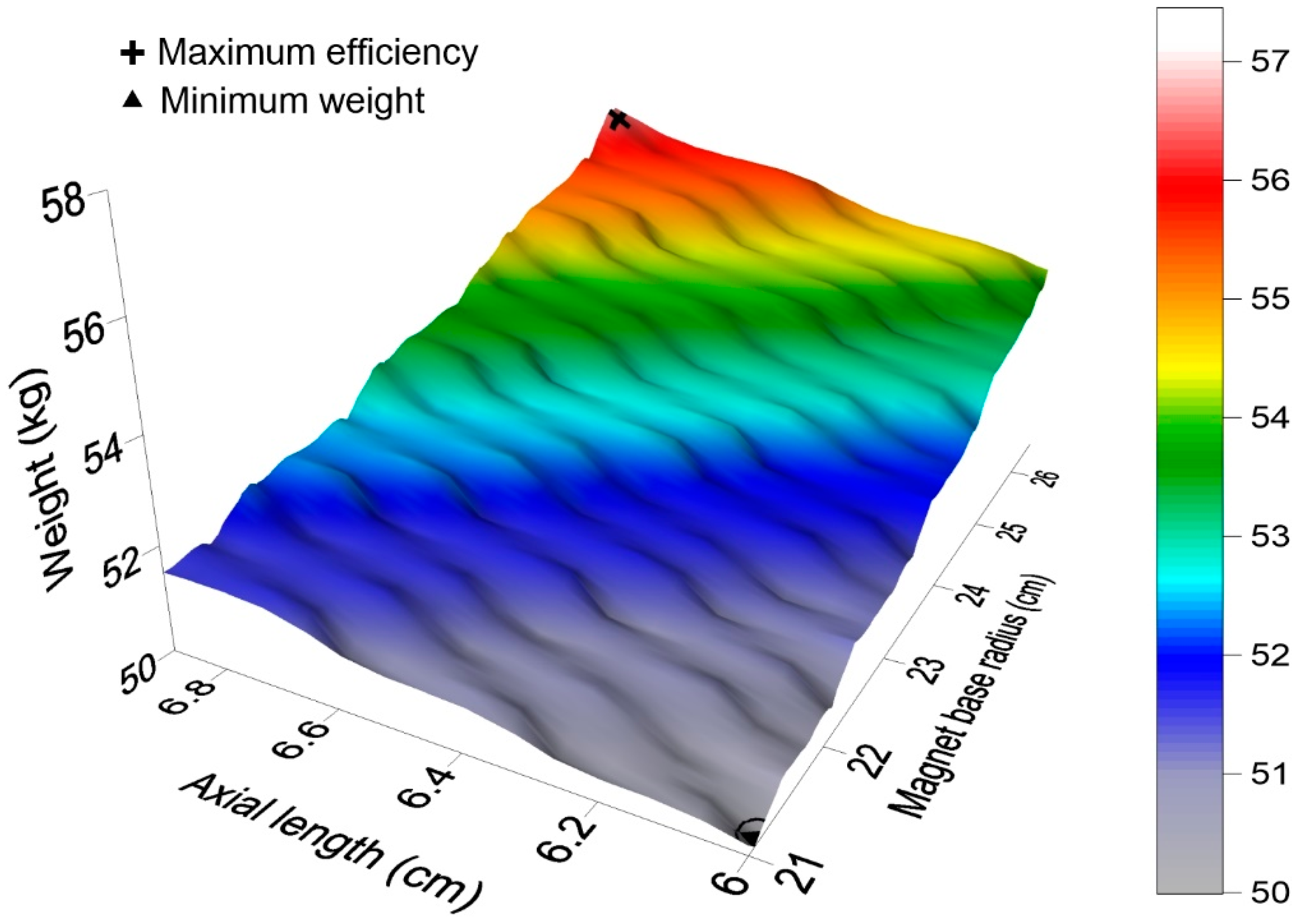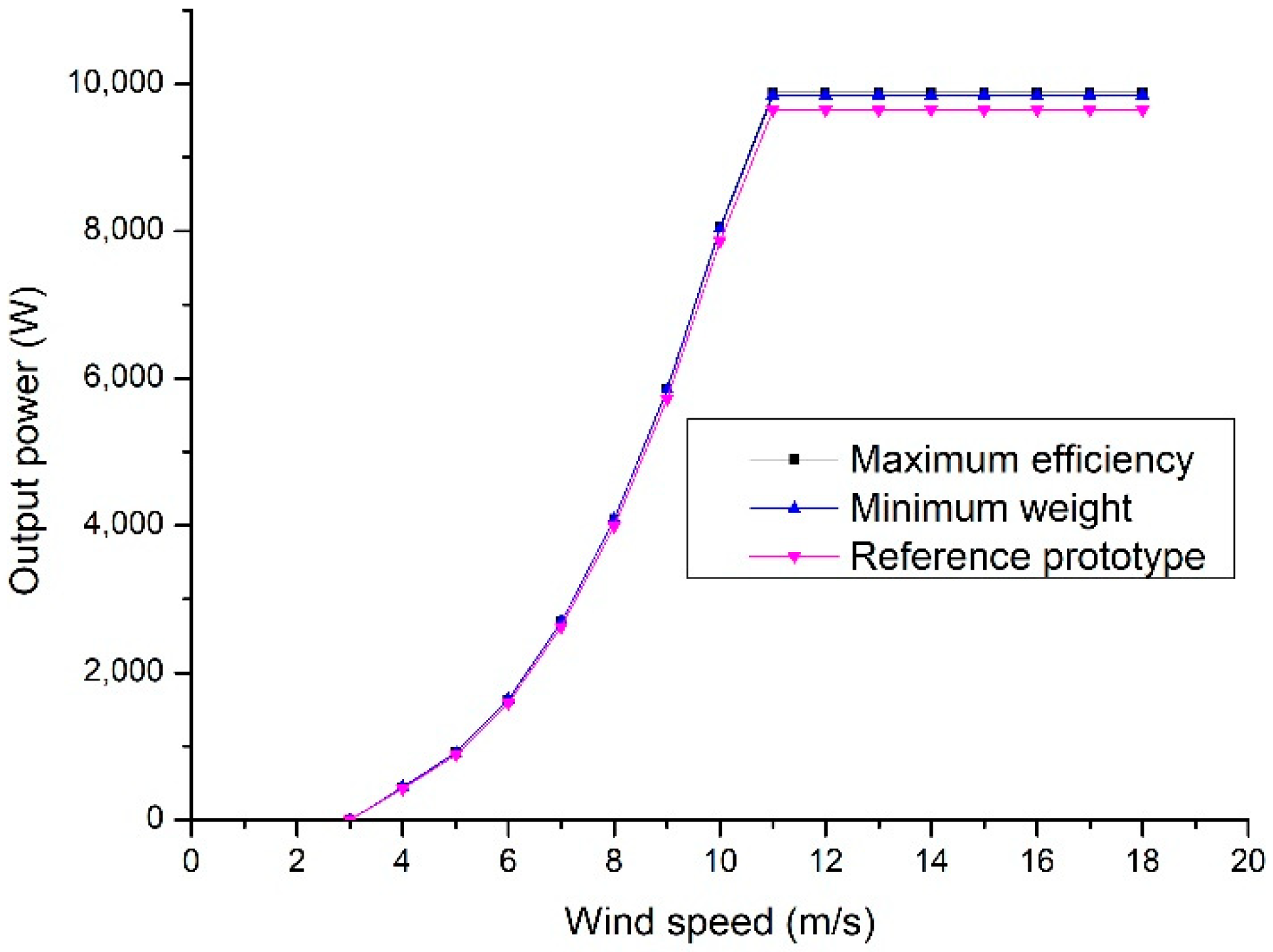Dimensioning Optimization of the Permanent Magnet Synchronous Generator for Direct Drive Wind Turbines
Abstract
:1. Introduction
2. Materials and Methods
2.1. Mechanical Power
2.2. Design Conditions
2.3. PMSG Design
2.4. PMGS Efficiency
2.5. Copper Losses
2.6. Iron Core Losses
2.7. Other Losses
2.8. Geometric Parameters of the PMSG
2.9. Electrical Parameters
2.10. Methodology Development
3. Results and Discussion
Simulation of a Wind Turbine Using the Optimal PMSG Designs
4. Conclusions
Author Contributions
Funding
Institutional Review Board Statement
Informed Consent Statement
Data Availability Statement
Acknowledgments
Conflicts of Interest
References
- Leung, D.Y.; Yang, Y. Wind Energy Development and Its Environmental Impact: A Review. Renew. Sustain. Energy Rev. 2012, 16, 1031–1039. [Google Scholar] [CrossRef]
- Bang, D.; Polinder, H.; Shrestha, G.; Ferreira, J.A. Review of Generator Systems for Direct-Drive Wind Turbines. In Proceedings of the European Wind Energy Conference and Exhibition, Brussels, Belgium, 31 March–3 April 2008; Volume 31, pp. 1–11. Available online: https://www.semanticscholar.org/paper/Review-of-Generator-Systems-for-Direct-Drive-Wind-Bang-Polinder/f69a9f66bfee76f0bb2f3d34a8d6ae20697c0bf4 (accessed on 29 September 2021).
- Saidur, R.; Rahim, N.; Islam, M.; Solangi, K. Environmental Impact of Wind Energy. Renew. Sustain. Energy Rev. 2011, 15, 2423–2430. [Google Scholar] [CrossRef]
- Bang, D.; Polinder, H.; Shrestha, G.; Ferreira, J.A. Comparative Design of Radial and Transverse Flux PM Generators for Direct-Drive Wind Turbines. In Proceedings of the 2008 18th International Conference on Electrical Machines, Vilamoura, Portugal, 6–9 September 2008; IEEE: Piscataway, NJ, USA, 2008; pp. 1–6. Available online: https://www.semanticscholar.org/paper/Comparative-design-of-radial-and-transverse-flux-PM-Bang-Polinder/a8ccb7f1f06860e0f98ab86f1b7aff92798c0c1d (accessed on 29 September 2021).
- Xu, Y.; Maki, N.; Izumi, M. Performance Comparison of 10-MW Wind Turbine Generators with HTS, Copper, and PM Excitation. IEEE Trans. Appl. Supercond. 2015, 25, 1–6. [Google Scholar]
- Akuru, U.; Kamper, M. Performance Comparison of Optimum Wound-Field and Ferrite PM Flux Switching Machines for Wind Energy Applications; IEEE: Piscataway, NJ, USA, 2016; pp. 2478–2485. Available online: https://ieeexplore.ieee.org/document/7732869 (accessed on 29 September 2021).
- Potgieter, J.H.; Kamper, M.J. Design of New Concept Direct Grid-Connected Slip-Synchronous Permanent-Magnet Wind Generator. IEEE Trans. Ind. Appl. 2012, 48, 913–922. [Google Scholar] [CrossRef]
- Potgieter, J.H.; Kamper, M.J. Torque and Voltage Quality in Design Optimization of Low-Cost Non-Overlap Single Layer Winding Permanent Magnet Wind Generator. IEEE Trans. Ind. Electron. 2011, 59, 2147–2156. [Google Scholar] [CrossRef]
- Eriksson, S.; Solum, A.; Leijon, M.; Bernhoff, H. Simulations and Experiments on a 12 KW Direct Driven PM Synchronous Generator for Wind Power. Renew. Energy 2008, 33, 674–681. [Google Scholar] [CrossRef]
- He, C.; Wu, T. Analysis and Design of Surface Permanent Magnet Synchronous Motor and Generator. Ces Trans. Electr. Mach. Syst. 2019, 3, 94–100. [Google Scholar] [CrossRef]
- Li, H.; Chen, Z.; Polinder, H. Optimization of Multibrid Permanent-Magnet Wind Generator Systems. IEEE Trans. Energy Convers. 2009, 24, 82–92. [Google Scholar] [CrossRef]
- Li, H.; Chen, Z. Design Optimization and Site Matching of Direct-Drive Permanent Magnet Wind Power Generator Systems. Renew. Energy 2009, 34, 1175–1184. [Google Scholar] [CrossRef]
- Kowal, D.; Sergeant, P.; Dupré, L.; Vandenbossche, L. The Effect of the Electrical Steel Properties on the Temperature Distribution in Direct-Drive PM Synchronous Generators for 5 MW Wind Turbines. IEEE Trans. Magn. 2013, 49, 5371–5377. [Google Scholar] [CrossRef]
- Zhang, J.; Cheng, M.; Chen, Z. Optimal Design of Stator Interior Permanent Magnet Machine with Minimized Cogging Torque for Wind Power Application. Energy Convers. Manag. 2008, 49, 2100–2105. [Google Scholar] [CrossRef]
- Faiz, J.; Zareh, N. Optimal Design of a Small Permanent Magnet Wind Generator for Rectified Loads; Linköping University Electronic Press: Linköping, Sweden, 2011; pp. 4193–4200. Available online: http://www.ep.liu.se/ecp/057/vol15/019/ecp57vol15_019.pdf (accessed on 29 September 2021).
- Bazzo, T.D.P.M.; Kölzer, J.F.; Carlson, R.; Wurtz, F.; Gerbaud, L. Multiphysics Design Optimization of a Permanent Magnet Synchronous Generator. IEEE Trans. Ind. Electron. 2017, 64, 9815–9823. Available online: https://doi.org/10.1109/tie.2017.2726983 (accessed on 29 September 2021). [CrossRef]
- Verde, A.; Lastres, O.; Hernández, G.; Ibañez, G.; Verea, L.; Sebastian, P. A New Method for Characterization of Small Capacity Wind Turbines with Permanent Magnet Synchronous Generator: An Experimental Study. Heliyon 2018, 4, e00732. [Google Scholar] [CrossRef] [PubMed] [Green Version]
- Eriksson, S.; Bernhoff, H. Loss Evaluation and Design Optimisation for Direct Driven Permanent Magnet Synchronous Generators for Wind Power. Appl. Energy 2011, 88, 265–271. [Google Scholar] [CrossRef]
- Jung, S.-Y.; Jung, H.; Hahn, S.-C.; Jung, H.-K.; Lee, C.-G. Optimal Design of Direct-Driven PM Wind Generator for Maximum Annual Energy Production. IEEE Trans. Magn. 2008, 44, 1062–1065. [Google Scholar] [CrossRef]
- Hao, H.; Fei, W.; Miao, D.; Jin, M.; Shen, J. Torque Characteristics in a Large Permanent Magnet Synchronous Generator with Stator Radial Ventilating Air Ducts. Front. Inf. Technol. Electron. Eng. 2016, 17, 814–824. [Google Scholar] [CrossRef]
- Penzkofer, A.; Atallah, K. Analytical Modeling and Optimization of Pseudo-Direct Drive Permanent Magnet Machines for Large Wind Turbines. IEEE Trans. Magn. 2015, 51, 1–14. [Google Scholar] [CrossRef]
- Tovar-Barranco, A.; Gómez, D.; López-de-Heredia, A.; Villar, I. High Torque Density Transverse Flux Permanent Magnet Machine Design for Wind Power Generation; IEEE: Piscataway, NJ, USA, 2016; pp. 782–788. Available online: https://ieeexplore.ieee.org/document/7732615 (accessed on 29 September 2021).
- Tapia, J.A.; Pyrhonen, J.; Puranen, J.; Lindh, P.; Nyman, S. Optimal Design of Large Permanent Magnet Synchronous Generators. IEEE Trans. Magn. 2012, 49, 642–650. [Google Scholar] [CrossRef]
- Chen, M.; Huang, L.; Tan, P.; Li, Y.; Ahmad, G.; Hu, M. A Stator-PM Transverse Flux Permanent Magnet Linear Generator for Direct Drive Wave Energy Converter. IEEE Access 2021, 9, 9949–9957. [Google Scholar] [CrossRef]
- Gammeter, C.; Drapela, Y.; Tüysüz, A.; Kolar, J.W. Weight Optimization of a Machine for Airborne Wind Turbines; IEEE: Piscataway, NJ, USA, 2014; pp. 950–958. [Google Scholar]
- McDonald, A.; Bhuiyan, N.A. On the Optimization of Generators for Offshore Direct Drive Wind Turbines. IEEE Trans. Energy Convers. 2016, 32, 348–358. [Google Scholar] [CrossRef] [Green Version]
- Tapia-Hernandez, A.; Ponce-Silva, M.; Mastache-Mastache, J.E.; Hernandez-Gonzalez, L. Efficiency Optimization for Radial Permanent Magnets Electric Generators; IEEE: Piscataway, NJ, USA, 2016; pp. 23–28. [Google Scholar]
- Madescu, G.; Trica, A.; Budisan, N.; Prostean, O.; Biriescu, M.; Mot, M. Performance Optimization of Low-Speed Induction Generators for Direct Drive Wind Turbines; IEEE: Piscataway, NJ, USA, 2007; pp. 166–171. [Google Scholar]
- Alshibani, S. Application of Particle Swarm Optimization in the Design of Halbach Permanent Magnet Synchronous Generators for Megawatt Level Wind Turbines; IEEE: Piscataway, NJ, USA, 2018; pp. 865–868. [Google Scholar]
- Tlali, P.M.; Wang, R.-J.; Gerber, S.; Botha, C.D.; Kamper, M.J. Design and Performance Comparison of Vernier and Conventional PM Synchronous Wind Generators. IEEE Trans. Ind. Appl. 2020, 56, 2570–2579. [Google Scholar] [CrossRef]
- Hanselman, D.C. Brushless Permanent Magnet Motor Design; The Writers’ Collective: Orono, ME, USA, 2003; ISBN 1-932133-63-1. [Google Scholar]
- Jassal, A.; Polinder, H.; Lahaye, D.; Ferreira, J. Analytical and FE Calculation of Eddy-Current Losses in PM Concentrated Winding Machines for Wind Turbines; IEEE: Piscataway, NJ, USA, 2011; pp. 717–722. [Google Scholar]









| Characteristic | Real Value | Reference | Error (%) |
|---|---|---|---|
| Mechanical angular speed | 210 rpm | 210.15 rpm | 0.07 |
| Line voltage | 242.81 V | 240 V | 1.17 |
| Output power | 10 kVA | 10.09 kVA | 0.89 |
| Current | 24.002 A | 24.0 A | 0.01 |
| Efficiency | 92% | 92.04% | 0.04 |
| Electrical frequency | 56.04 Hz | 56 Hz | 0.07 |
| Inner resistance | 0.27 Ω | 0.27 Ω | 0.00 |
| Total weight | 82.0 kg | 82.0 kg | 0.00 |
| Power | 10 kW |
| FEM | 260 V |
| Mechanical angular speed | 210 rpm |
| Electrical frequency | 56 Hz |
| Number of phases | 3 |
| Air gap | 0.1 cm |
| Slot opening | 0.3 cm |
| Shoe depth fraction | 5 |
| Number of slots per phase per pole | 1 |
| Characteristics | Reference | Maximum Efficiency | Minimum Weight |
|---|---|---|---|
| Apparent power | 10.09 kVA | 10.21 kVA | 10.18 kVA |
| Current | 24.00 A | 24.53 A | 23.25 A |
| Line voltage | 240 V | 240.4 V | 252.8 V |
| Efficiency | 92.04% | 93.1% | 92.79% |
| Iron losses | 411.27 W | 408.95 W | 369.93 W |
| Copper losses | 466.64 W | 348.23 W | 421.18 W |
| Inner resistance | 0.27 Ω | 0.192 Ω | 0.259 Ω |
| Total weight | 82.00 kg | 56.75 kg | 49.89 kg |
| Axial length | 19.70 cm | 6.89 cm | 5.91 cm |
| Output stator radius | 18.85 cm | 31.75 cm | 27.98 cm |
| Magnet base radius | 14.30 cm | 26.5 cm | 21.1 cm |
| Power density | 123.12 W/kg | 180.03 W/kg | 204.11 W/kg |
| Shape factor | 1.8 |
| Scale factor | 8.43 m/s |
| Air density | 1.225 kg/m3 |
| Mechanical power | 10,974 W |
| Input speed | 3 m/s |
| Output velocity | 18 m/s |
| Speed of the design | 10.7 m/s |
| Power coefficient | 0.4 |
| Lambda of the design | 7 |
| PMGS | AEP (kWh) |
|---|---|
| Prototype | 33,076 |
| Maximum efficiency | 33,870 |
| Minimum weight | 33,808 |
Publisher’s Note: MDPI stays neutral with regard to jurisdictional claims in published maps and institutional affiliations. |
© 2021 by the authors. Licensee MDPI, Basel, Switzerland. This article is an open access article distributed under the terms and conditions of the Creative Commons Attribution (CC BY) license (https://creativecommons.org/licenses/by/4.0/).
Share and Cite
Santiago, J.A.E.; Danguillecourt, O.L.; Duharte, G.I.; Díaz, J.E.C.; Añorve, A.V.; Hernandez Escobedo, Q.; Enríquez, J.P.; Verea, L.; Galvez, G.H.; Portela, R.D.; et al. Dimensioning Optimization of the Permanent Magnet Synchronous Generator for Direct Drive Wind Turbines. Energies 2021, 14, 7106. https://doi.org/10.3390/en14217106
Santiago JAE, Danguillecourt OL, Duharte GI, Díaz JEC, Añorve AV, Hernandez Escobedo Q, Enríquez JP, Verea L, Galvez GH, Portela RD, et al. Dimensioning Optimization of the Permanent Magnet Synchronous Generator for Direct Drive Wind Turbines. Energies. 2021; 14(21):7106. https://doi.org/10.3390/en14217106
Chicago/Turabian StyleSantiago, Jesús Antonio Enríquez, Orlando Lastres Danguillecourt, Guillermo Ibáñez Duharte, Jorge Evaristo Conde Díaz, Antonio Verde Añorve, Quetzalcoatl Hernandez Escobedo, Joel Pantoja Enríquez, Laura Verea, Geovanni Hernández Galvez, Rafael Dorrego Portela, and et al. 2021. "Dimensioning Optimization of the Permanent Magnet Synchronous Generator for Direct Drive Wind Turbines" Energies 14, no. 21: 7106. https://doi.org/10.3390/en14217106
APA StyleSantiago, J. A. E., Danguillecourt, O. L., Duharte, G. I., Díaz, J. E. C., Añorve, A. V., Hernandez Escobedo, Q., Enríquez, J. P., Verea, L., Galvez, G. H., Portela, R. D., & Perea-Moreno, A.-J. (2021). Dimensioning Optimization of the Permanent Magnet Synchronous Generator for Direct Drive Wind Turbines. Energies, 14(21), 7106. https://doi.org/10.3390/en14217106








